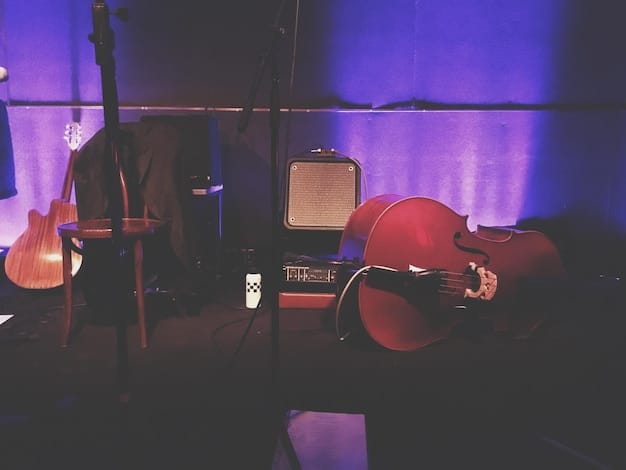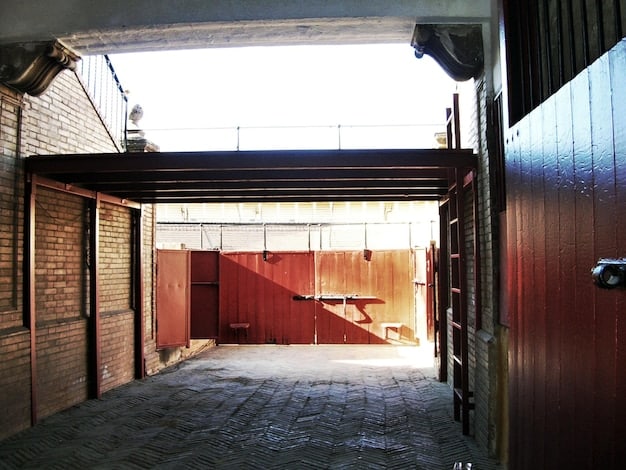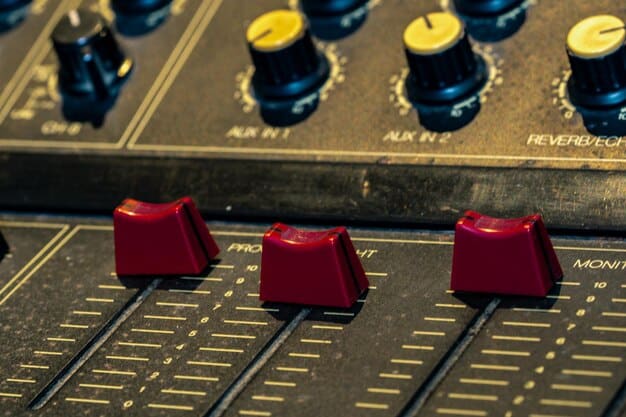How to Start a DIY Music Venue in the US: A 2025 Guide

Starting a DIY music venue in the US in 2025 involves finding a suitable space, securing necessary permits, building a community, booking diverse acts, and promoting your venue effectively.
Dreaming of opening your own alternative music space? This guide dives deep into how to start a successful DIY music venue in the US: a step-by-step guide for 2025, providing the knowledge and tools you need to turn your passion into reality.
Crafting Your Vision: Defining Your DIY Music Venue
Before hammering the first nail or booking your first band, take time to define your vision. What kind of music venue do you want to create? What atmosphere are you aiming for? Getting clear on these questions will set the foundation for a successful venture.
Identifying Your Niche
The music scene is vast and varied. Instead of trying to be everything to everyone, consider specializing in a particular genre or style. Do you want to focus on punk rock, experimental electronica, indie folk, or something else entirely? Identifying your niche will help you attract a dedicated audience and stand out from the competition.
Defining Your Target Audience
Who are you trying to reach with your music venue? Are you targeting college students, young professionals, or a more mature crowd? Understanding your target audience will influence everything from the location and design of your venue to the types of bands you book and the prices you charge.
- Consider creating audience personas to represent your ideal customers.
- Research the demographics and preferences of your target audience in your chosen location.
- Use social media and online surveys to gather insights and feedback.
By defining your vision and identifying your niche and target audience, you’ll have a clear roadmap for building a unique and thriving DIY music venue.
Location, Location, Location: Finding the Perfect Space
The location of your DIY music venue is critical for success. It needs to be accessible, affordable, and suitable for live music. Finding the right space might take some time, but it’s worth the effort to get it right.

Researching Potential Neighborhoods
Start by researching neighborhoods that align with your target audience and musical niche. Look for areas with a vibrant arts scene, a strong sense of community, and a reasonable cost of living. Consider factors like proximity to public transportation, parking availability, and the presence of other entertainment venues.
Don’t overlook up-and-coming neighborhoods that may offer more affordable rent and a greater opportunity to shape the local culture.
Assessing the Physical Space
Once you’ve identified potential neighborhoods, it’s time to start looking at specific properties. Look for spaces with high ceilings, good acoustics, and enough square footage to accommodate your desired capacity. Consider factors like the existing layout, the condition of the building, and the potential for renovations.
- Check local zoning laws to ensure that live music venues are permitted in the area.
- Investigate the building’s soundproofing and noise mitigation features.
- Assess the electrical and plumbing systems to ensure they can handle the demands of a music venue.
Finding the perfect space requires diligent research and careful assessment, but it’s a crucial step in launching a successful DIY music venue.
Navigating the Legal Landscape: Permits, Licenses, and Insurance
Opening a DIY music venue involves navigating a complex web of legal requirements. From permits and licenses to insurance and safety regulations, it’s essential to understand and comply with all applicable laws.
Securing Necessary Permits and Licenses
The specific permits and licenses you’ll need will vary depending on your location and the nature of your business. Common requirements include a business license, a liquor license (if you plan to serve alcohol), and a live entertainment permit. Contact your local city hall or business licensing office to learn more about the requirements in your area.
Understanding Insurance Requirements
Insurance is essential for protecting your business from potential liabilities. Common types of insurance for music venues include general liability insurance, property insurance, and workers’ compensation insurance (if you have employees). Shop around for the best rates and coverage options to ensure you’re adequately protected.
- Consult with an insurance broker who specializes in the entertainment industry.
- Consider purchasing event-specific insurance for larger or more risk-prone shows.
- Develop a comprehensive risk management plan to identify and mitigate potential hazards.
Navigating the legal landscape can be challenging, but it’s a necessary step in ensuring the long-term viability of your DIY music venue. Seek professional advice from lawyers and insurance brokers to ensure you’re fully compliant with all applicable laws.
Building Your Stage: Sound, Lighting, and Venue Design
The technical aspects of your music venue play a crucial role in creating a memorable experience for both performers and audience members. Investing in quality sound and lighting equipment, and designing a functional and aesthetically pleasing space, will set your venue apart from the competition.

Investing in Quality Sound Equipment
A great sound system is essential for any successful music venue. Invest in high-quality speakers, amplifiers, microphones, and a mixing board that can handle the demands of live music. Consider hiring a professional sound engineer to help you set up and operate your equipment.
Creating a Dynamic Lighting System
Lighting can dramatically enhance the atmosphere of your music venue. Invest in a variety of lighting fixtures, including spotlights, floodlights, and colored lights, to create a dynamic and visually appealing environment. Consider hiring a lighting designer to help you create a lighting plan that complements your venue’s aesthetic.
Experiment with different lighting techniques to create a unique and memorable experience for your audience.
Designing a Functional and Aesthetically Pleasing Space
The design of your music venue should be both functional and aesthetically pleasing. Consider factors like stage placement, seating arrangements, and acoustics when planning your layout. Use colors, textures, and decorations to create a unique and inviting atmosphere.
Incorporate DIY elements and local art to give your venue a distinct sense of personality and community.
Building a great stage requires a combination of technical expertise and creative vision. By investing in quality equipment and designing a functional and aesthetically pleasing space, you can create a music venue that is both enjoyable for performers and memorable for audience members.
Booking the Bands: Curating Your Musical Lineup
The success of your DIY music venue hinges on the quality and diversity of your musical lineup. Booking talented and engaging bands that appeal to your target audience is essential for attracting a loyal following.
Reaching Out to Local and Regional Bands
Start by reaching out to local and regional bands that fit your venue’s musical niche. Attend local shows, network with musicians, and use online resources to find potential acts. Offer fair compensation and a supportive environment to attract top talent.
Diversifying Your Genre Selection
While it’s important to focus on your core musical niche, don’t be afraid to diversify your genre selection from time to time. Consider booking bands from different genres that share a similar artistic sensibility or appeal to a similar audience. This can help you attract new fans and keep your venue fresh and exciting.
- Create a booking calendar to track upcoming shows and ensure a diverse lineup.
- Develop relationships with booking agents and promoters to expand your reach.
- Offer residency programs for local bands to foster a sense of community.
Curating a great musical lineup requires a combination of networking, research, and a keen ear for talent. By booking talented and engaging bands from a variety of genres, you can create a music venue that is both exciting and sustainable.
Promoting Your Venue: Spreading the Word
No matter how great your music venue is, it won’t succeed if no one knows about it. Effective marketing and promotion are essential for attracting audience members and building a loyal following.
Building a Strong Online Presence
In today’s digital age, a strong online presence is crucial for any business. Create a website and social media profiles for your music venue, and use them to promote upcoming shows, share photos and videos, and engage with your audience. Consider using email marketing to keep your fans informed about upcoming events and special offers.
Leveraging Local Media and Partnerships
Reach out to local media outlets, including newspapers, magazines, and radio stations, to promote your music venue. Partner with local businesses and organizations to cross-promote your events and reach a wider audience. Consider sponsoring local events or hosting benefit concerts to raise awareness and support the community.
- Use targeted advertising on social media to reach potential audience members in your area.
- Offer discounts and promotions to students, seniors, and other specific demographics.
- Host open mic nights and other community events to attract new talent and audience members.
Promoting your venue requires a multifaceted approach that combines online marketing, local media outreach, and community partnerships. By leveraging these strategies effectively, you can spread the word about your music venue and attract a loyal following.
| Key Point | Brief Description |
|---|---|
| 📍 Location | Choose an accessible, music-friendly spot. |
| 🎶 Booking | Curate diverse, engaging musical acts. |
| 📢 Promotion | Spread the word online and locally. |
| ✅ Legal | Secure permits, licenses, and insurance. |
FAQ
▼
A DIY music venue is typically an independently owned and operated space focusing on alternative or underground music. They often emphasize community and artistic expression over profit.
▼
Costs vary greatly, depending on location, renovations, and equipment. Expect to spend anywhere from a few thousand to tens of thousands of dollars to get started.
▼
General liability insurance is essential, covering potential accidents or injuries on your property. You might also need property insurance and workers’ compensation if you have employees.
▼
Leverage social media, create a website, partner with local businesses, and reach out to local media. Word-of-mouth and community engagement are also incredibly effective.
▼
A strong sense of community, diverse and engaging musical acts, a cool atmosphere, and effective promotion. Staying adaptable and responsive to your audience is also key.
Conclusion
Starting a DIY music venue in the US is no easy feat, but with careful planning, hard work, and a passion for music, you can create a thriving space that contributes to your local alternative culture scene, offering a unique experience for performers and audiences alike. Remember to stay adaptable and connected to your community.





